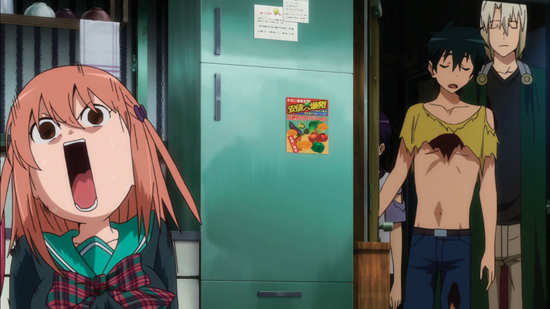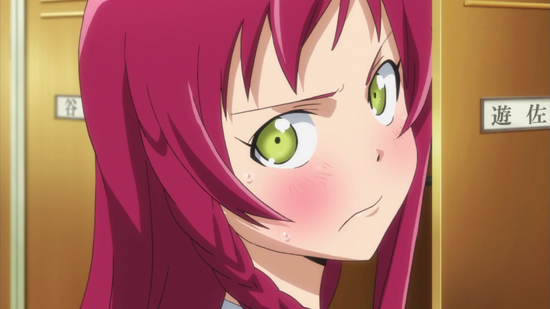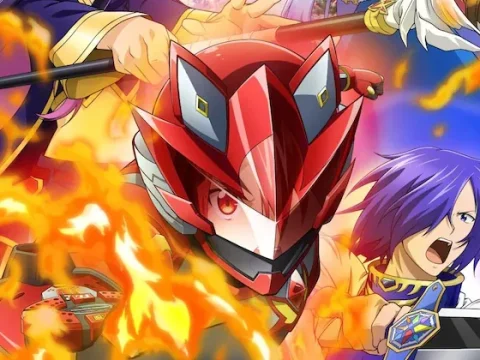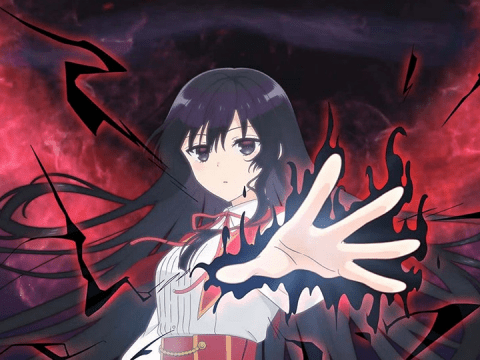
In an alternate dimension, Satan, ruler of demons, commands a horde of creatures of the night on an island bordered directly to the north, south, east, and west by human-inhabited islands. Together, these islands form Ente Isla, and one day Satan decides to conquer it all so that he and his faithful followers can exist in peace. The war waged by the bloodthirsty demons under command of Satan’s four loyal generals conquers in quick succession nearly all four of the surrounding nations.
But at the last second, when all seems lost, a church-trained, semi-divine hero (Emi Yusa) rises up and pushes the horde all the way back to its home island and straight into Satan’s castle. Just before what would have been his inevitable defeat, Satan opens up a portal and flees with his right-hand general (Alciel) into another dimension … “our” dimension. After arriving, Satan and Alciel discover they’ve taken on the seemingly irreversible form of weak, near-magic-less humans with a need for food as well as well as some means to procure it. Thus the Devil becomes a red-shirted part-timer at a yellow-arched-themed fast food establishment called MgRonald.

While that might seem like a spoilerific description of a show, it’s actually just the first few minutes. The majority of The Devil Is a Part-Timer!, available via FUNimation and based on an ongoing light novel series written by Satoshi Wagahara, is a fantastical take on a slice-of-life romantic comedy with a little action thrown in for good measure. What’s a big bad do when he’s stripped of all his powers and tries to live in Tokyo on a part-timer’s salary while fending off assailants from another dimension? The answers will have you laughing … not because they’re funny but because the show knows they’re not.
In fact, the efforts of Satan, who adopts the antiquated and openly mocked moniker Sadao Mao, and his master plan are so pathetic that they consistently thwart the very intuitions of and motivations behind those with any modicum of compassion seeking to exact their revenge on the former demon lord. Exploiting his enemies’ initial and continuously re-inspired sense of disappointment in Satan as Sadao is where the show inevitably finds its wealth of relatively understated funny.
It’s the execution of the little things in this show that makes it work; concentrating on the character who’s speaking might make viewers miss out on one or two sight gags in the background. This imagery, such as sign/object placement and a range of very real and often intricate facial reactions that lie just outside of the main focus are what endow these characters with individuality and dimension. Otherwise, dialogue has a tendency to degrade most interactions into repetitive conflict, character stereotype abuse, or boob jokes.
It also doesn’t help that the unexpectedly sly means of character development is intermittently undermined by back stories that usually induce befuddlement regarding conflicts of motivation and action. Feeling bad for your nemesis is funny, but that can only be excused for so long after the motivations for revenge pile up and come to light. But because the focus on relationships isn’t just romantic or just adversarial, the writing manages to distract from the faults of both scenarios by seamlessly switching between and combining them.

This chemistry helps the show move along at a good and humorous clip, while the intermittent action mentioned earlier is less for the sake of adrenaline than it is for introductions and forwarding the plot whenever necessary. Along the line, Satan finds out that he’s been followed to Tokyo not only by Emi Yusa but by other ill-intentioned parties from Entre Isla as well. Certain characters are in immediate opposition to Sadao, while others sway in an ambiguous state of either confusion or aloofness.
Almost everyone currently in Tokyo from Ente Isla shows a concern for the limits placed upon themselves by being in this dimension, which maintains a good sense of world, and the series does stay within those same rules during and after combat to further increase believability. Physical injuries do occur even though the weapon being wielded is magic, and the bloody consequences (while very few and far between) do get fairly realistic treatment.
Credit is due WHITE FOX for two things in particular with regard to the animation: effectively distinguishing Ente Isla-influenced action from day-to-day Tokyo life and making the differences between the two so drastic that doing so adds another layer to the comedy. Tokyo life is tons of bright colors, clean city streets, and a crowd of round faces with pointy chins. But at the flick of the action switch, lines are thicker, the world becomes shadowed, and the color palate is darker.

In the same vein, Atsushi Ikariya must be commended for adapting original artist Oniku’s character designs for the series. Each is as bland as bland can be until transforming/appearing in their Ente Isla form, when they grow larger than life with harder and grizzlier details, to complement setting changes perfectly. The sheer contrast would be laughable if it weren’t intentional. In fact, it’s exactly this overdramatic playfulness that forces the audience to keep in mind just who these characters really are and laugh at them because of it.
That said, the series is not exactly about throwing stones. It doesn’t go out of its way to foster sympathy for the devil (and Alciel); doing so is just a matter of following its own premise. Sadao is never shown as a fool, after all, merely as someone who believes a little too hard in the mundane. This again highlights the show’s strength, which involves an empowered mythical being becoming obsessed by the trite, and is funny as (if you’ll pardon the pun) hell.
But the vulnerability of the great demon lord Satan, as poked fun of by his Earthbound situation, may not be as ridiculous as it seems. The series is a lot smarter than it lets on up front. Thinking back to the show’s prologue, Satan, while known for his terror and cruelty, wants to wipe out humanity to live in peace. This implies he and his kind have been targets of malice and hunted, and a statement from Sadao as to why he likes this world actually hints at this.

The Devil Is a Part-Timer! has a lot going on underneath its surface despite the behind-the-counter smile. Until recognized as the tools of a comédie pathétique, the antagonism and self-deprecation tossed about by the characters might come across as salt in sympathy’s wound or simply pass over as unappreciated circumstance.
But once it becomes clear that the finger is pointed at the sheer absurdity of the situation rather than the plight of quasi- realistically portrayed youths, opportunities for laughter abound. The show has a lot of opportunity for social commentary, but it’s not as heavy as all that. All this series wants to do is make you laugh, and there were very few times when I was not grinning at something or other during the entire run.
This story originally was originally posted on 11/20/2015.







